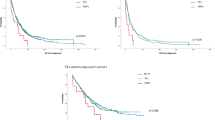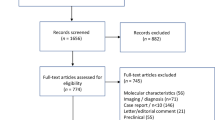Abstract
Solitary plasmacytomas are uncommon plasma cell disorders, which may present as a single bone lesion (P-bone) or extramedullary plasmacytoma (P-EM). There is a paucity of large studies analyzing prognostic factors and outcomes of plasmacytomas. While the treatment of choice is radiation therapy (RT), there is a lack of data evaluating optimal RT dose. In this study, we sought to answer these questions by utilizing the National Cancer Database plasmacytoma data from 2000 to 2011. A total of 5056 patients were included in the study (median age 62 years; range 52–72). To obtain a pure plasmacytoma cohort, potential multiple myeloma patients were excluded from the study (bone marrow involvement, systemic chemotherapy use). P-bone constituted 70% of the patients. The median overall survival (OS) of P-EM was significantly longer than P-bone (132 vs. 85 months), and for soft/connective tissue it was worse than remainder of P-EM (82 vs. 148 months). On multivariable analysis, factors associated with worse OS included older age (≥65), presence of P-bone, and treatment with a radiation dose <40 Gy.
This is a preview of subscription content, access via your institution
Access options
Subscribe to this journal
Receive 12 print issues and online access
$259.00 per year
only $21.58 per issue
Buy this article
- Purchase on Springer Link
- Instant access to full article PDF
Prices may be subject to local taxes which are calculated during checkout



Similar content being viewed by others
References
Dores GM, Landgren O, McGlynn KA, Curtis RE, Linet MS, Devesa SS. Plasmacytoma of bone, extramedullary plasmacytoma, and multiple myeloma: incidence and survival in the United States, 1992–2004. Br J Haematol. 2009;144:86–94.
Thumallapally N, Meshref A, Mousa M, Terjanian T. Solitary plasmacytoma: population-based analysis of survival trends and effect of various treatment modalities in the USA. BMC Cancer. 2017;17:13.
Holland J, Trenkner DA, Wasserman TH, Fineberg B. Plasmacytoma. Treatment results and conversion to myeloma. Cancer. 1992;69:1513–7.
Knobel D, Zouhair A, Tsang RW, Poortmans P, Belkacemi Y, Bolla M, et al. Prognostic factors in solitary plasmacytoma of the bone: a multicenter Rare Cancer Network study. BMC Cancer. 2006;6:118.
Knowling MA, Harwood AR, Bergsagel DE. Comparison of extramedullary plasmacytomas with solitary and multiple plasma cell tumors of bone. J Clin Oncol. 1983;1:255–62.
Warsame R, Gertz MA, Lacy MQ, Kyle RA, Buadi F, Dingli D, et al. Trends and outcomes of modern staging of solitary plasmacytoma of bone. Am J Hematol. 2012;87:647–51.
Weberpals J, Pulte D, Jansen L, Luttmann S, Holleczek B, Nennecke A, et al. Survival of patients with lymphoplasmacytic lymphoma and solitary plasmacytoma in Germany and the United States of America in the early 21st century. Haematologica. 2017;102:e229–e232.
National Comprehensive Cancer Network. Multiple Myeloma (Version 3. 2017). Accessed July 24th, 2017. https://www.nccn.org/professionals/physician_gls/PDF/myeloma.pdf.
Strobl C, Malley J, Tutz G. An introduction to recursive partitioning: rationale, application, and characteristics of classification and regression trees, bagging, and random forests. Psychol Methods. 2009;14:323–48.
Soutar R, Lucraft H, Jackson G, Reece A, Bird J, Low E, et al. Guidelines on the diagnosis and management of solitary plasmacytoma of bone and solitary extramedullary plasmacytoma. Br J Haematol. 2004;124:717–26.
Frassica DA, Frassica FJ, Schray MF, Sim FH, Kyle RA. Solitary plasmacytoma of bone: Mayo Clinic experience. Int J Radiat Oncol Biol Phys. 1989;16:43–48.
Ozsahin M, Tsang RW, Poortmans P, Belkacemi Y, Bolla M, Dincbas FO, et al. Outcomes and patterns of failure in solitary plasmacytoma: a multicenter Rare Cancer Network study of 258 patients. Int J Radiat Oncol Biol Phys. 2006;64:210–7.
Sasaki R, Yasuda K, Abe E, Uchida N, Kawashima M, Uno T, et al. Multi-institutional analysis of solitary extramedullary plasmacytoma of the head and neck treated with curative radiotherapy. Int J Radiat Oncol Biol Phys. 2012;82:626–34.
Tournier-Rangeard L, Lapeyre M, Graff-Caillaud P, Mege A, Dolivet G, Toussaint B, et al. Radiotherapy for solitary extramedullary plasmacytoma in the head-and-neck region: a dose greater than 45 Gy to the target volume improves the local control. Int J Radiat Oncol Biol Phys. 2006;64:1013–7.
Acknowledgements
Funding
This research was funded by the Mayo Clinic Division of Hematology funds for the Hematology and Oncology Outcomes Research (HONOR) Group. This publication was also supported by the National Cancer Institute of the National Institutes of Health under Award Number K23CA218742.
Author contributions
GG designed the study, interpreted the data, and wrote the paper with assistance from WIG and SK; ACB, JI, and SF performed statistical analysis; NDS, ALM, AAA, PK, UD, SKH, MAS, FKB, RSG, and RAK critically reviewed the manuscript, and approved the final version
Author information
Authors and Affiliations
Corresponding author
Ethics declarations
Conflict of interest
SK has research support for clinical trials from Abbott Laboratories, Amgen Inc.; Celgene Corporation; Janssen Pharmaceutica Products, LP; Novartis Pharmaceuticals Corporation; sanofi-aventis US; and Takeda Pharmaceuticals North America Inc. He serves as a scientific advisor for Amgen Inc., Bristol-Myers Squibb Company, Celgene Corporation, GlycoMimetics, Janssen Pharmaceutica Products, LP, sanofi-aventis US, and Takeda Pharmaceuticals North America Inc. The other authors declare that they have no conflict of interest.
Electronic supplementary material
Rights and permissions
About this article
Cite this article
Goyal, G., Bartley, A.C., Funni, S. et al. Treatment approaches and outcomes in plasmacytomas: analysis using a national dataset. Leukemia 32, 1414–1420 (2018). https://doi.org/10.1038/s41375-018-0099-8
Received:
Revised:
Accepted:
Published:
Issue Date:
DOI: https://doi.org/10.1038/s41375-018-0099-8
This article is cited by
-
A prognostic nomogram and risk classification system of elderly patients with extraosseous plasmacytoma: a SEER database analysis
Journal of Cancer Research and Clinical Oncology (2023)
-
Impact of prior diagnosis of monoclonal gammopathy on outcomes in newly diagnosed multiple myeloma
Leukemia (2019)



